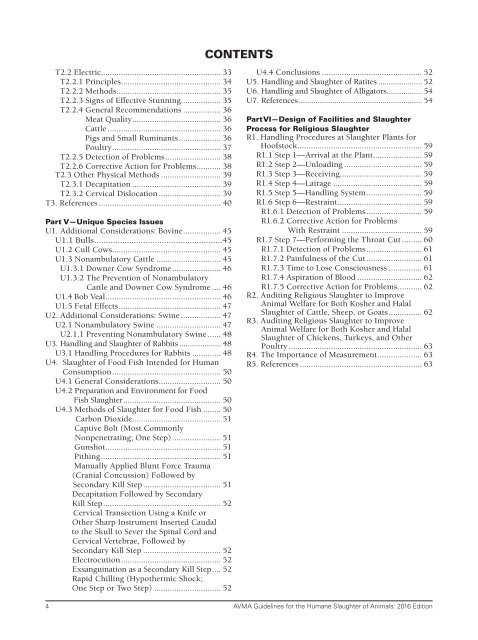Humane-Slaughter-Guidelines
Create successful ePaper yourself
Turn your PDF publications into a flip-book with our unique Google optimized e-Paper software.
CONTENTS<br />
T2.2 Electric...................................................... 33<br />
T2.2.1 Principles.............................................. 34<br />
T2.2.2 Methods................................................ 35<br />
T2.2.3 Signs of Effective Stunning................... 35<br />
T2.2.4 General Recommendations.................. 36<br />
Meat Quality......................................... 36<br />
Cattle.................................................... 36<br />
Pigs and Small Ruminants.................... 36<br />
Poultry.................................................. 37<br />
T2.2.5 Detection of Problems.......................... 38<br />
T2.2.6 Corrective Action for Problems............ 38<br />
T2.3 Other Physical Methods............................ 39<br />
T2.3.1 Decapitation......................................... 39<br />
T2.3.2 Cervical Dislocation............................. 39<br />
T3. References........................................................ 40<br />
Part V—Unique Species Issues<br />
U1. Additional Considerations: Bovine.................. 45<br />
U1.1 Bulls........................................................45<br />
U1.2 Cull Cows................................................. 45<br />
U1.3 Nonambulatory Cattle.............................. 45<br />
U1.3.1 Downer Cow Syndrome....................... 46<br />
U1.3.2 The Prevention of Nonambulatory<br />
Cattle and Downer Cow Syndrome..... 46<br />
U1.4 Bob Veal..................................................... 46<br />
U1.5 Fetal Effects............................................... 47<br />
U2. Additional Considerations: Swine................... 47<br />
U2.1 Nonambulatory Swine.............................. 47<br />
U2.1.1 Preventing Nonambulatory Swine....... 48<br />
U3. Handling and <strong>Slaughter</strong> of Rabbits..................... 48<br />
U3.1 Handling Procedures for Rabbits.............. 48<br />
U4. <strong>Slaughter</strong> of Food Fish Intended for Human<br />
Consumption.................................................. 50<br />
U4.1 General Considerations............................. 50<br />
U4.2 Preparation and Environment for Food<br />
Fish <strong>Slaughter</strong>............................................. 50<br />
U4.3 Methods of <strong>Slaughter</strong> for Food Fish......... 50<br />
Carbon Dioxide........................................ 51<br />
Captive Bolt (Most Commonly<br />
Nonpenetrating; One Step)....................... 51<br />
Gunshot..................................................... 51<br />
Pithing....................................................... 51<br />
Manually Applied Blunt Force Trauma<br />
(Cranial Concussion) Followed by<br />
Secondary Kill Step.................................... 51<br />
Decapitation Followed by Secondary<br />
Kill Step...................................................... 52<br />
Cervical Transection Using a Knife or<br />
Other Sharp Instrument Inserted Caudal<br />
to the Skull to Sever the Spinal Cord and<br />
Cervical Vertebrae, Followed by<br />
Secondary Kill Step.................................... 52<br />
Electrocution.............................................. 52<br />
Exsanguination as a Secondary Kill Step..... 52<br />
Rapid Chilling (Hypothermic Shock;<br />
One Step or Two Step)............................... 52<br />
U4.4 Conclusions.............................................. 52<br />
U5. Handling and <strong>Slaughter</strong> of Ratites...................... 52<br />
U6. Handling and <strong>Slaughter</strong> of Alligators................. 54<br />
U7. References............................................................ 54<br />
Part VI—Design of Facilities and <strong>Slaughter</strong><br />
Process for Religious <strong>Slaughter</strong><br />
R1. Handling Procedures at <strong>Slaughter</strong> Plants for<br />
Hoofstock......................................................... 59<br />
R1.1 Step 1—Arrival at the Plant....................... 59<br />
R1.2 Step 2—Unloading.................................... 59<br />
R1.3 Step 3—Receiving..................................... 59<br />
R1.4 Step 4—Lairage......................................... 59<br />
R1.5 Step 5—Handling System.......................... 59<br />
R1.6 Step 6—Restraint....................................... 59<br />
R1.6.1 Detection of Problems.......................... 59<br />
R1.6.2 Corrective Action for Problems<br />
With Restraint..................................... 59<br />
R1.7 Step 7—Performing the Throat Cut.......... 60<br />
R1.7.1 Detection of Problems.......................... 61<br />
R1.7.2 Painfulness of the Cut.......................... 61<br />
R1.7.3 Time to Lose Consciousness................ 61<br />
R1.7.4 Aspiration of Blood.............................. 62<br />
R1.7.5 Corrective Action for Problems............ 62<br />
R2. Auditing Religious <strong>Slaughter</strong> to Improve<br />
Animal Welfare for Both Kosher and Halal<br />
<strong>Slaughter</strong> of Cattle, Sheep, or Goats................ 62<br />
R3. Auditing Religious <strong>Slaughter</strong> to Improve<br />
Animal Welfare for Both Kosher and Halal<br />
<strong>Slaughter</strong> of Chickens, Turkeys, and Other<br />
Poultry............................................................. 63<br />
R4. The Importance of Measurement..................... 63<br />
R5. References........................................................ 63<br />
4 AVMA <strong>Guidelines</strong> for the <strong>Humane</strong> <strong>Slaughter</strong> of Animals: 2016 Edition



